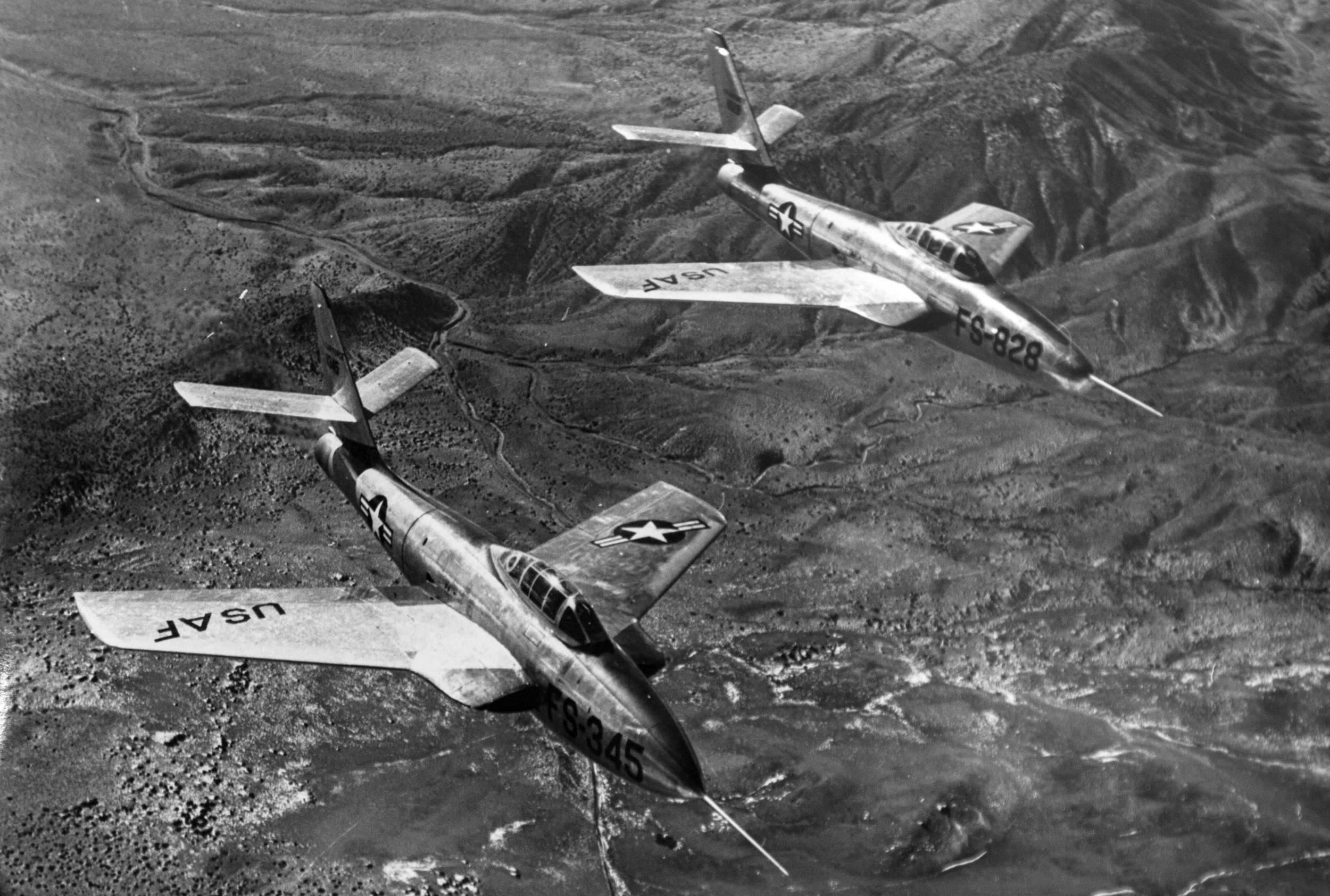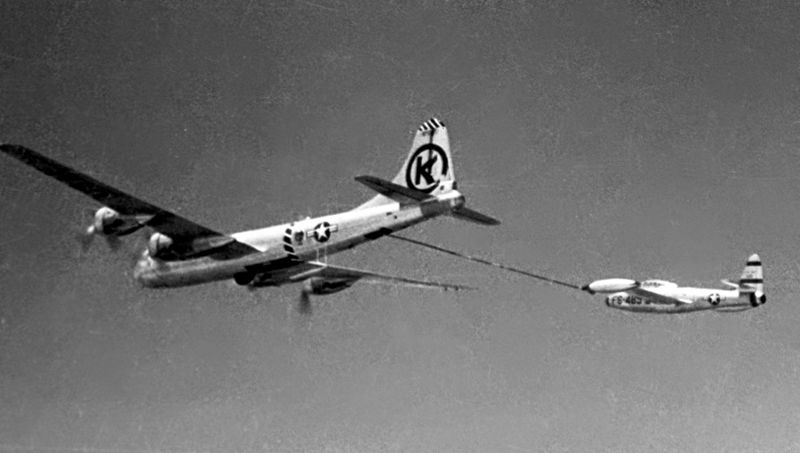“F-84G was the first fighter with built-in aerial refueling capability and the first single-seat aircraft capable of carrying a nuclear bomb.”
Uploaded by saja maja on 2013-01-05.
The Republic F-84 Thunderjet was an American turbojet fighter-bomber aircraft. Originating as a 1944 United States Army Air Forces (USAAF) proposal for a "day fighter", the F-84 flew in 1946. Although it entered service in 1947, the Thunderjet was plagued by so many structural and engine problems that a 1948 U.S. Air Force review declared it unable to execute any aspect of its intended mission and considered canceling the program. The aircraft was not considered fully operational until the 1949 F-84D model and the design matured only with the definitive F-84G introduced in 1951. In 1954, the straight-wing Thunderjet was joined by the swept-wing F-84F Thunderstreak fighter and RF-84F Thunderflash photo reconnaissance aircraft.
The Thunderjet became the USAF's primary strike aircraft during the Korean War, flying 86,408 missions and destroying 60% of all ground targets in the war as well as eight Soviet-built MiG fighters. Over half of the 7,524 F-84s produced served with NATO nations, and it was the first aircraft to fly with the U.S. Air Force Thunderbirds demonstration team. The USAF Strategic Air Command had F-84 Thunderjets in service from 1948 through 1957.
Nicknamed "The Hog", the F-84 was the first production fighter aircraft to utilize inflight refueling and the first fighter capable of carrying a nuclear weapon, the Mark 7 nuclear bomb. Modified F-84s were used in several unusual projects, including the FICON and Tom-Tom dockings to the B-29 Superfortress and B-36 bomber motherships, and the experimental XF-84H Thunderscreech supersonic turboprop.
The F-84 nomenclature can be somewhat confusing. The straight-wing F-84A to F-84E and F-84G models were called the Thunderjet. The F-84F Thunderstreak and RF-84F Thunderflash were a different airplane with swept wings. The XF-84H Thunderscreech (not its official name) was an experimental turboprop version of the F-84F. The F-84F swept wing version was intended to be a small variation of the normal Thunderjet with only a few different parts, so it kept the basic F-84 number. Production delays on the F-84F resulted in another order of the straight-wing version; this was the F-84G.
Notable achievements
A KB-29 refueling an F-84E over Korea. F-84Es could only refuel the wingtip tanks separately.
- The F-84 was the first aircraft flown by the U.S. Air Force Thunderbirds, which operated F-84G Thunderjets from 1953 to 1955 and F-84F Thunderstreaks from 1955 to 1956. The F-84E was also flown by the Skyblazers team of United States Air Forces Europe (USAFE) from 1950 to 1955.
- On 7 September 1946, the second XP-84 prototype set a national speed record of 607.2 mph (527.6 kn, 977.2 km/h), slightly slower than the world record 612.2 mph (532.0 kn, 985.2 km/h) held by the British Gloster Meteor.
- On 22 September 1950, two EF-84Es, flown by David C. Schilling and Col. William Ritchie, flew across the North Atlantic from Great Britain to the United States. Ritchie's aircraft ran out of fuel over Newfoundland but the other successfully made the crossing which took ten hours two minutes and three aerial refuelings. The flight demonstrated that large numbers of fighters could be rapidly moved across the Atlantic.
- F-84G was the first fighter with built-in aerial refueling capability and the first single-seat aircraft capable of carrying a nuclear bomb.
- On 20 August 1953, 17 F-84Gs using aerial refueling flew from the United States to the United Kingdom. The 4,485-mile (3,900 nmi, 7,220 km) journey was the longest-ever nonstop flight by jet fighters.
- In 1955, an F-84G became the first aircraft to be Zero length launched from a trailer.
F-84 VARIANTS: Straight-wing
The XP-84A and YP-84As XP-84
The first two prototypes.
XP-84A
The third prototype with a more powerful J35-GE-15 engine. This airframe was subsequently modified with a pointed fairing over the intake and lateral NACA intakes were installed into the intake trunks.
YP-84A
Service test aircraft; 15 built.
P-84B (F-84B)
First production version, J35-A-15 engine; 226 built.
F-84C
Reverted to the more reliable J35-A-13 engine, improved fuel, hydraulic and electrical systems; 191 built.
F-84D
J35-A-17 engine, various structural improvements. The pitot tube was moved from the tail fin to the splitter in the air intake with fins added to the wingtip fuel tanks; 154 built.
EF-84D
Two F-84Ds, EF-84D 48-641 and EF-84D 48-661 were modified with coupling devices; 641 starboard wing, 661 port wing for "Tip-Tow Project MX106 Wing Coupling Experiments." An EB-29A 44-62093 was modified with coupling devices on both wings. Because of the difference in landing gear lengths, the three aircraft took off separately and couple/uncoupled in flight. The pilot of 641 was Major John M. Davis and the pilot of 661 was Major C.E. "Bud" Anderson.
"One of the more interesting experiments undertaken to extend the range of the early jets in order to give fighter protection to the piston-engine bombers, was the provision for inflight attachment/detachment of fighter to bomber via wingtip connections. One of the several programs during these experiments was done with a B-29 mother ship and two F-84D 'children', and was code named 'Tip Tow'. A number of flights were undertaken, with several successful cycles of attachment and detachment, using, first one, and then two F-84s. The pilots of the F-84s maintained manual control when attached, with roll axis maintained by elevator movement rather than aileron movement. Engines on the F-84s were shut down in order to save fuel during the 'tow' by the mother ship, and inflight engine restarts were successfully accomplished. The experiment ended in disaster during the first attempt to provide automatic flight control of the F-84s, when the electronics apparently malfunctioned. The left hand F-84 rolled onto the wing of the B-29, and the connected aircraft both crashed with loss of all on board personnel (Anderson had uncoupled so was did not crash with the other two aircraft)."
F-84E
J35-A-17D engine, Sperry AN/APG-30 radar-ranging gunsight, retractable attachments for RATO bottles, inboard wing hardpoints made "wet" to permit carrying an additional pair of 230 U.S. gal (870 L) fuel tanks. Most aircraft were retrofitted with F-84G-style reinforced canopies. The fuselage was stretched 15"; the canopy was lengthened 8", the canopy frame was lengthened 12" (accounting for another 4"), and a 3" splice panel was added aft of the canopy. The stretch was not done to enlarge the cockpit but rather to enable a larger fuel tank, provide additional space for equipment under the canopy behind the pilot's seat, and to improve aerodynamics. This can be distinguished from earlier models by the presence of two fuel vents on ventral rear fuselage, the added radar in the nose splitter, and the pitot tube was moved downward from mid-height in the splitter (as on the F-84D) to clear the radar installation. 843 built. F-84E 49-2031 was a test aircraft for air-to-air missiles. F-84E 50-1115 was a test aircraft for the FICON project.
EF-84E
Two F-84Es were converted into test prototypes, to test various methods of air-to-air refueling. EF-84E 49-2091 was used as a probe-and-drogue test aircraft. The probe was mid-span on the port wing. Production aircraft with probes (removable) had the probe fitted to the auxiliary wing tanks. EF-84E 49-2115 was used as a FICON test aircraft with a B-36 host. EF-84E 49-1225 and EF-84E 51-634 were test aircraft for the ZELMAL (Zero-length launch, Mat landing) experiments version for point defense, used the booster rocket from MGM-1 Matador cruise missile.
F-84G
Single-seat fighter-bomber capable of delivering the Mark 7 nuclear bomb using the LABS, J35-A-29 engine, autopilot, capable of inflight refueling using both the boom (receptacle in left wing leading edge) and drogue (probe fitted to wingtip fuel tanks), introduced the multi-framed canopy which was later retrofitted to earlier straight-winged F-84s. A total of 3,025 were built (1,936 for NATO under MDAP). The larger engine required more air to the face of the engine than the intake could provide at taxiing speeds. Commencing with block 20, auxiliary "suck-in" doors were added laterally to the intake runners ahead of the wing roots. When the engine was deficient of air, the spring-loaded doors were sucked open by the vacuum created by the engine to allow additional air to the engine. When the aircraft reached sufficient airspeed to supply adequate air through the nose intake, the auxiliary doors would close. F-84G 51-1343 was modified with a periscope system to test the periscope installation proposed for the Republic XF-103.
F-84KX
Eighty ex-USAF F-84Bs converted into target drones for the United States Navy.
RF-84G
F-84G Thunderjets converted by France and Yugoslavia for recon duty with cameras in the ventral fuselage and modified auxiliary wing tanks.
YF-96A aka YF-84F aka YRF-84K
F-84E 49-2430 converted to swept wing configuration. The "first prototype" for the F-84F Thunderstreak. Canopy and ventral speed brake carried over from Thunderjet. Originally with a V-windscreen, later reverted to the standard Thunderjet flat windscreen. Modified by adding a fixed hook at the weapons bay and anhedral horizontal tailplane to enable FICON tests (trapeze capture) with GRB-36D mother ship. The airframe was capable of higher speeds than the Thunderjet engine could deliver. The YF-84F was a follow on with a larger engine and deepened fuselage.
YF-84F
F-84G 51-1344 converted to swept wing configuration. The "second prototype" for the F-84F Thunderstreak. Fuselage deepened by 7" to accommodate larger engine. Canopy and ventral speed brake carried over from Thunderjet, tail configuration same as YF-96A.
YF-84F aka YRF-84F
F-84G 51-1345 converted to swept wing configuration with a pointed nose and lateral intakes. This was a test airframe to evaluate the effects of moving the intakes to the wing roots. Like 1344, the fuselage was deepened by 7" to accommodate larger engine. Canopy and ventral speed brake carried over from Thunderjet, tail configuration same as YF-96A.
Tip-Tow
See EF-84D above, did not become operational.
Tom-Tom
Two RF-84K and B-36 wingtip coupling experiment, did not become operational.
FICON
F-84E and GRB-36D trapeze system, became operational.
F-84 VARIANTS: Swept-wing
YF-84F
Two swept-wing prototypes of the F-84F, initially designated YF-96A.
F-84F Thunderstreak
Swept wing version with Wright J65 engine.
RF-84F Thunderflash
Reconnaissance version of the F-84F, 715 built.
RF-84K FICON project
Reconnaissance version of the F model, 25 built to hang from the Consolidated B-36 Peacemaker.
XF-84H Thunderscreech
Experimental supersonic-turboprop version.
YF-84J
Two conversions with the General Electric J73 engine.



